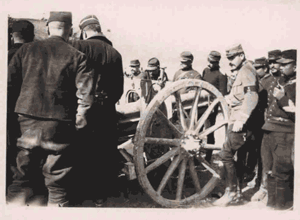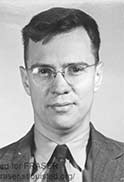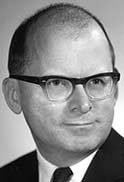Fed Officials' Trips through 20th Century History
Whether by plane, train or boat, Fed officials and future Fed officials have traveled to history’s stage—from World War I, to India’s Green Revolution, to the USSR’s glasnost.
You can take historical trips with them via the collections in the St. Louis Fed’s digital library FRASER and read the very human stories of some of the people who lived through momentous times.
Traveling amid the Great War in Europe

Benjamin Strong Jr., circa 1915. Image from papers held at the New York Fed; digitized for FRASER.
1916: The United States’ central banking system was founded in 1913 after President Woodrow Wilson signed the Federal Reserve Act into law.
A few years later, Benjamin Strong Jr., who was the first president (then called governor) of the New York Fed, set sail for Europe to make plans for the banking arrangements of the Federal Reserve System in London, Paris and Holland.
At the time, World War I was raging.
Strong conceded in a 1916 letter to a Paris contact that it would be difficult to determine “just how far we can go or would be willing to go [with the arrangements] prior to the conclusion of the war,” but the fact that he would be traveling in countries at war did not deter him.
Included in his papers in the Federal Reserve Bank of New York archives are photographs of war scenes taken before Strong’s 1916 trip by an unknown photographer.
The 104 pages of photos and their labeled backs include a 1914 photo of “Paris motor-buses carrying the 20th Army Corps driving the race to the sea,” among others.

Included in Benjamin Strong Jr.'s papers in the New York Fed archives are photographs of World War I scenes.
Before, after and during his trip, Strong helped family and friends volunteer in the war effort. Along with Americans including Ernest Hemingway, Strong’s son, Ben, and “one or two” of Ben’s friends sought to help near the front.
Henry Herman Harjes, Strong’s Paris contact, had organized an ambulance service for the American Red Cross, and Strong in his 1916 letter asked him for advice on the young men “either driving an ambulance or in some form of the service” in France.
Strong’s extensive international travels continued throughout the 1920s as he promoted more effective cooperation among the world’s central banks, according to a biography on the Federal Reserve History website.
Funding Mining and Metal in Brazil
1946: William McChesney Martin Jr. was Fed chairman from 1951 to 1970. Before that, and after serving in the U.S. Army during World War II, the St. Louis native was chairman of the Export-Import Bank of the United States.

William McChesney Martin Jr., circa 1943. Image from papers held at the Missouri History Museum; digitized for FRASER.
Martin and three other Export-Import Bank officials visited Brazil in October 1946 for the dedication of a steel mill the bank had helped fund, and to find out about the general economic situation and projects the bank was interested in.
Those included an iron ore project in the southeast of the country, which Martin spoke about to then-Brazilian President Eurico Gaspar Dutra. The conversations on a train en route to the steel mill dedication had to be conducted through one of Dutra’s cabinet officers because of a language barrier.
“Mr. Martin expressed the great interest of the Export-Import Bank in completion of development of the Vale do Rio Doce,” according to a report by bank Secretary Sidney Sherwood. “Each time Mr. Martin expressed this, the President smiled, nodded and indicated that he understood.”
During another part of the trip, a car ride on winding roads outside Rio de Janeiro gave the bank officials jitters, and a misunderstanding about road speeds made matters worse.
“Our nerves had reached the breaking point when we saw the needle on the speedometer touch 95 and were only slightly relieved when our engineer companion explained it indicated kilometers equivalent to about 65 miles per hour,” Sherwood wrote.
Seeing the Aftermath of World War II
1947: As Export-Import Bank chairman, Martin also traveled through Europe after the war’s end. His wife, fellow St. Louis native Cynthia Davis Martin, traveled with him and took careful notes on its effects on everything from food supplies to morale.
Cities’ conditions varied wildly, according to her accounts circa 1947.
London still was “gaping full of wounds” from bombing. In otherwise seemingly untouched blocks, single houses had suffered direct hits, she wrote.
On the inside walls of those houses, “one could still see the paint, the panels of the livingroom (sic), the papered walls of the diningroom (sic) and upstairs the pinks and blues for the bedrooms,” Cynthia Martin wrote.
But in Holland, “the countryside is greatly restored, some entire villages rebuilt entirely in bricks. …”
The Green Revolution in India
1965: Then-Minneapolis Fed President Hugh G. Galusha traveled to India in the midst of the Green Revolution to speak with central and commercial bankers and others.
While there, he talked with Dave Hopper, then an agricultural economist for the Rockefeller Foundation.

Hugh D. Galusha Jr., president of the Minneapolis Fed from 1965-71. Image from Federal Reserve History.
Farmers in India had been growing a type of wheat that spent most of its energies on growing high and bushy to protect itself from the sun and neighboring competitors, Galusha said in his account of his conversation with Hopper.
Then experimenting started in Mexico with short wheat that would respond to fertilizer and produce heavy heads and a stiff straw. According to Hopper, no one really knew the implications of this discovery in Mexico for tropical agriculture, Galusha said in his notes.
“It was almost on impulse that an experimental plot was tried in India and it proved enormously successful,” he said.
The farmers “accepted the new wheat with great enthusiasm and a lively black market developed in the seed. Acreage expanded geometrically, and today Hopper figures that there is roughly a 10-year lead on the population growth,” Galusha said.
But Hopper also said there were concerns that small landowners couldn’t afford the higher yielding varieties and the fertilizers to go with them.
Galusha spoke about those concerns in visits with other officials. He discussed them with Herbert Spivack, political and economic officer in the U.S. Embassy in New Delhi, and two top officials in the India Ministry of Finance’s Department of Economic Affairs: I.G. Patel, special secretary, and V.K. Ramaswami, chief economic advisor.
The officials suggested that the problem wouldn’t emerge for a while, according to Galusha. “They believed that the problem, if there is one, can be handled for some years to come by better distribution of credit and agricultural inputs to equalize the disproportion between the larger land units and the smallest ones,” Galusha said.
The “Enormous” Challenges of Soviet Changes
October 1989: Then-Fed Chairman Alan Greenspan traveled to Moscow when the Soviet Union was in the midst of reforms that included moving toward glasnost, or openness; loosening centralized control of economic systems; and restructuring political systems.
In a speech at the U.S. Embassy in Moscow, Greenspan outlined principles of commercial and central banking, saying that changes in financial structure were essential for successful economic restructuring.
“Dynamic economies are always in a state of evolution, but I would guess that there are few examples in history to rival the scope of the restructuring now being undertaken in the Soviet economy,” Greenspan said, according to the transcript of the speech in FRASER.
“The challenges are enormous, but so are the potential rewards.”

In this April 1991 photo, taken a couple of years after Alan Greenspan’s 1989 visit to Moscow, Greenspan (left front) is shown during a visit to the Federal Reserve Bank of St. Louis. Others pictured are St. Louis Fed board members Robert H. Quenon (back left), H. Edwin Trusheim (back right) and then-St. Louis Fed President Thomas C. Melzer.
This blog explains everyday economics and the Fed, while also spotlighting St. Louis Fed people and programs. Views expressed are not necessarily those of the St. Louis Fed or Federal Reserve System.
Email Us


